

Location: Solovetsky island, Archangelsk region Map
6 islands with 300 km2
First settlement: 5000 BC
Found: 1429
Site: here
Hotels, motels and where to sleep
Spaso-Preobrazhensky Solovetsky Monastery is a stavropegic
monastery of the Russian Orthodox Church, located in the village of
Solovetsky, Primorsky District, Arkhangelsk Region on Solovetsky
Island in the White Sea.
It arose in the 1420s-1430s, rebuilt
in stone by the labors of St. Philip, in pre-Petrine times was
listed among the largest landowners of the state. In 1669-1676 it
was besieged by the tsarist troops as one of the centers of
resistance to the Nikonian reforms.
Under Soviet rule, the
country's first special-purpose camp operated on the territory of
the monastery, and the Solovetsky Museum-Reserve was also created,
which was reorganized in 1974 into the Solovetsky State Historical,
Architectural and Natural Museum-Reserve. Monastic life was resumed
on October 25, 1990.
In 1992, the complex of monuments of the
Solovetsky Museum-Reserve was included in the UNESCO World Heritage
List, in 1995 - in the State Code of Particularly Valuable Cultural
Heritage Sites of the Peoples of the Russian Federation.

The first monastic settlement arose in 1429, when the Monks Savvaty
and Herman settled here and spent six years in seclusion here. In
1436, after the death of Savvaty, Zosima arrived on the island, who
founded here a monastery and two wooden churches - the
Transfiguration of the Lord and Nicholas the Wonderworker. Akhbishop
Jonah sent Abbot Paul here, who was replaced by Abbot Zosima in
1442. In 1485 and 1538 there were strong fires, as a result, in
1552, stone construction of churches began, and in 1590-1594 a
defensive granite wall was rebuilt. In 1651, instead of the abbess,
an archimandry was established. Until March 1682, when the
Kholmogory diocese was established, the monastery was located within
the Novgorod diocese.
The flourishing of the monastery in the
16th century is associated with the activities of the hegumen
Philip, who was elected in 1548 by the monastery cathedral and was
elevated to the rank of hegumen by the Novgorod Archbishop
Theodosius. Hegumen Philip put a lot of work on the internal and
external improvement of the monastery. Large monetary contributions
from the tsar and other benefactors made it possible to build two
large churches: in honor of the Dormition of the Most Holy Theotokos
and the Transfiguration of the Lord. The relics of the founders of
the monastery, Saints Zosima and Savvaty, were transferred to the
latter. Thanks to the tsar's right of duty-free trade in salt and
exemplary economic activity of Abbot Philip, the monastery became
the richest industrial and cultural center of northern Pomorie.
Philip arranged a network of canals between the numerous lakes on
the Solovetsky Island, installed mills on them, erected a number of
new outbuildings, and increased household inventory; On the Pomor
lands, the number of salt brewhouses increased, and the first
ironmaking weapons factory in the Korel district was organized on
the banks of the Pyala River.
With his righteous life, the
Solovetsky abbot acquired universal respect, and the fame of him and
of his life spread so far that it reached Tsar Ivan the Terrible,
who summoned Philip from the Solovetsky monastery and offered to
take the chair of the Metropolitan of Moscow.
On August 5,
1621, the Tsar's letter came to the Solovetsky Monastery, which said
that since Solovki is a "Ukrainian place" (outskirts), the monastery
must be strengthened, stone dwelling houses for service people
should be built and there was a need to "a moat near the Solovetsky
city, which will be laid out with stone ... dig it out, and cut it
out with a stone and beat the garlic. "
The future Patriarch
Nikon at the age of 30 was tonsured in 1635 with his own name in the
Holy Trinity Anzersky Skete of the Solovetsky Monastery. After some
time, the Monk Eleazar of Anzersk, the initial elder of the skete,
included in the number of Nikon's duties the celebration of the
liturgies and the management of the economic part. But in 1639,
having come into conflict with Eleazar, Nikon fled from the skete
and was later admitted to the Kozheozersky monastery.
The
monastery condemned the church reform of Patriarch Nikon as heresy.
The confrontation took the form of a siege (the so-called Solovetsky
seat), which lasted from 1668 to 1676. In 1676, the fortress was
taken as a result of the betrayal of one of the monks. Almost all of
the rebellious monks were killed. Balthazar Coyette, who came to
Arkhangelsk in 1675 as part of the Dutch embassy, recorded in his
memoirs the story of a pilot that the monastery was besieged by 10
thousand archers and that the monks, having 300 guns and supplies
for 30 years, bravely defended themselves. Later, however, the Dutch
learned that the monastery had been captured, as most of the monks
fled.
Crafts flourished in the monastery: he owned salt pans,
smithies; monks and novices caught and raised fish, hunted animals,
and grew vegetables. The economy of the monastery reached a
particular prosperity under the abbot Irinarkh (1613-1626).
At the same time, the monastery fought for natural resources. In the
middle of the 17th century, the monastery took possession of the
village of Udor near the Seryogov salt field (770 km from Solovki)
on the Vymi River (now the Komi Republic). To establish the salt
industry, the leadership of the monastery sent three plenipotentiary
representatives to Seryogovo. 170 people arrived with them,
including 50 archers. Between the Solovetsky Monastery and the
merchant Filatiev (in 1678 he opened a small fishery for salt), on
the one hand, and the local salt-maker Pankratyev, on the other
hand, a “war” began, described in the petition of the second side as
follows: and stabbed with spears and his man Ivashka Yakimov was
shot to death, four people were wounded and the workers of 5 yards
were burned. " In Moscow, Pankratyev managed to initiate a lawsuit
against competitors, succeeded in replacing the Yarensk voivode
(Filatyev's patron), hired and sent 20 "his" Ustyug riflemen to
Seryogovo. After that, Filatiev's craft fell into decay, and the
Solovetsky Monastery abandoned its claims to the extraction of salt.
In honor of this victory in the "war" between the owner of the plant
Pankratyev and the archers of the Solovetsky Monastery and the
people of Filatyev, a cross was erected on the river bank in 1684.
Along with Kemyu, the Solovetsky monastery was an important border fortress with a garrison and artillery. By the 17th century, there were about 350 monks, 600-700 novices and peasants in the monastery. Twice, on July 7, 1694 and on August 10, 1702, Tsar Peter Alekseevich visited the monastery, and in June 1844 - Prince Konstantin Nikolaevich. After visiting the monastery by Peter I, several more monasteries were attributed to Solovetsky, including the Krasnokholmskaya hermitage in the Moscow region. In 1765 the monastery became stavropegic, that is, it came under the direct subordination of the Synod. The monastery had an extensive library, and by the 20th century, its own hydroelectric power station appeared.
In the nineteenth century Solovetsky Monastery unexpectedly becomes a strategic military location. Despite the fact that the cannons were removed from the monastery walls in 1814, the monastery still had enough firepower to repel British attack in 1854 during the Crimean War. Two British warships "Brisk" and "Miranda" failed to break the defenses and had to retreat from the Solovetsky archipelago despite firing over 1800 rounds fired at the monastery. British naval officers didn't dare to venture into the Solovetsky Monastery bay out of fear they might run aground and become easy targets. So they stayed at the far distance firing cannons with little effect. Both ships were forced to retreat.
Just several months later British ships arrived at the doorsteps of the Solovetsky Monastery. The head of the monastery refused to invite foreign soldiers on the sacred grounds. Instead he met their representatives on the shores of the White Sea. The British left without achieving any results. They could force monks to give up their monastery, but the British couldn't take the citadel without significant loss of life. They retreated again. The monks carved an inscription on a rock on a site of the meeting as a dedication to God's grace. This Negotiation Rock as it is known today is still visible.
Monastic prison
From the 16th to the beginning of the 20th
century, the monastery also served as a political and church
prison. The chambers in the monastery towers and the walls of
this monastery had the shape of a truncated cone, about three
meters long, two meters wide and two meters high, and one meter
at the narrow end. According to various estimates, from the time
of Ivan the Terrible to 1883, from 500 to 550 prisoners passed
through the prison of the Solovetsky Monastery, including such
notable personalities as P.A.Tolstoy, V.L.Dolgorukov, P.I.
Kalnyshevsky, F.P. Shakhovskoy.
The Solovetsky prison
existed until 1883, when the last prisoners were taken out of
it, but the guard soldiers were kept in it until 1886. After the
official closure of the prison, the Solovetsky Monastery
continued to serve as a place of exile for the guilty church
ministers.
Solovetsk biological station
In 1881, the
abbot of the monastery, Archimandrite Melety (Shergin), who was
notable for his interest in nature and sciences, together with
the professor of St. Petersburg University Nikolai Wagner,
created a biological station at the monastery with a huge
aquarium room at that time and a hydrobiological laboratory
equipped with the latest technology. In addition to the
biological station, Melety created a meteorological station and
a geophysical observatory at the monastery. The Solovetsky
biological station existed until 1899.
In 1996, the
Solovetsky branch of the White Sea Biological Station of Moscow
State University was created.
After October Revolution in 1917 Communists started to implement their atheist beliefs. In 1918 first platoon of Red Guards shows up on the island and confiscates part of the food provisions from a monastery. This was followed by complete closure in 1920. The head of Soviet government M.S. Kedrov who arrived on the island ordered execution its abbot Archimandrite Veniamin (Benjamin) (Kononov) along with his personal aid ieromonk Nikifor (Kuchin). Both were closed in a small house and subsequently burned alive near river Lodma. Ironically the date of the death coincided with Russian Orthodox Easter of 1928. Between 1922- 1939 Solovetsky Monastery was turned into concentration camp. It became officially known as Solovetsky Lager' Osobogo Naznachenia, which is translated as the "Solovki Special Purpose Camp". Its Russian acronym SLON, that is also translated as "elephant", became widely known among prisoners and later among common Russians. Later experience of Solovetsky concentration camp or simply Solovki as it became popularly known, was used in establishing a massive Gulag system all across the Soviet Union. It is no surprise that Aleksandr Solzhenitsyn called SLON "the mother of Gulag".
In 1939 SLON was given to the Northern Military Navy and a school of young officers was established here. On October 25th 1990 the archipelago was transferred to Russian Orthodox Church once again. Soviet stars were removed and Christian crosses were raised to their rightful location. Even though it is an active monastery, it is open to the tourists.

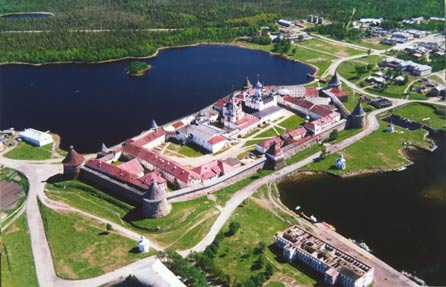
Kremlin is not just a description of military fortifications in Moscow. It is a general term that describes any defended Russian or Ukrainian city. Solovetsky Monastery in this sense is no exception. Main complex of Solovki Monastery was constructed from huge boulder that reach thickness of up to 6 meters. Massive round towers protected the site from all directions. Each tower was intended as a semi- autonomous defense position. If parts of the wall fell, defenders would retreat to these walls and close themselves inside.
This stone is located on the shore just south of Kremlin. It was placed here to commemorate retreat of the British fleet after second failed attempt to take Solovetsky Monastery during the Crimean War.
It is hard to imagine that cold archipelago in the middle of the White Sea could harbor any significant diversity of life. Yet human ingenuity and prowess made it possible. Over 100 plant species of different plants are found on the islands of the Solovetsky Monastery. Many were brought from other parts of the World as a donation to the monastic community. Unfortunately many of the species went extinct during the Soviet period, yet the tradition to grow various plants comes back.
Obviously Botanical Garden is the center of such biodiversity. It is located north of the main Kremlin. The explanation of such unusual growth is actually quite simple. Solovetsky Monastery accepted thousands of pilgrims from all across Russia and abroad annually. Additionally close to 1000 people lived on the island. The need for candles for the churches of the monastery required a local monastic factory that produced thousands of candles. The heat from the this massive production was channeled into small covered farms of the Botanical Garden. Monks of Solovetsky Monastery created a true miracle of the Russian North. They grew many species of flowers and fruits, including pineapple in the midst of unforgiving cold northern climate.
Solovki Island has numerous lakes left from the times of the Ice Age. Tons of ice carved lakes, but it left no rivers. The monks quickly changed this situation by digging canals that cover parts of the island. Starting from the 16th century under leadership of hegumen (head of the monastery) Phillip inhabitants of the monastery connected 52 lakes into one single meshwork of channels. They were used for transport of fish and merchandise. Today it is used by tourists and locals alike.
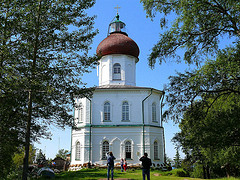 Sekirnaya
Hill is situated north of the main Kremlin complex on the
highest mountain on the island. Monks
constructed a Church of Ascension here. The church also served
as a lighthouse with a lens placed at the base of the cross.
During Soviet years, then Solovki were turned into a
concentration camp, the church was turned into worst punishment.
It was always cold and few prisoners survived here. Among these
lucky survivors was Vladimir Stepanovich Gundyaev, a priest who
was punished by atheist government for serving masses at his
house and also grand father of current Russian Patriarch Cyril. A
Commemoration Cross was erected here after fall of Soviet Union.
Sekirnaya Hill is also notable for its ancient burials and a
religious pagan complex that once stood here. It was abandoned
centuries before first Christian monks settled here.
Sekirnaya
Hill is situated north of the main Kremlin complex on the
highest mountain on the island. Monks
constructed a Church of Ascension here. The church also served
as a lighthouse with a lens placed at the base of the cross.
During Soviet years, then Solovki were turned into a
concentration camp, the church was turned into worst punishment.
It was always cold and few prisoners survived here. Among these
lucky survivors was Vladimir Stepanovich Gundyaev, a priest who
was punished by atheist government for serving masses at his
house and also grand father of current Russian Patriarch Cyril. A
Commemoration Cross was erected here after fall of Soviet Union.
Sekirnaya Hill is also notable for its ancient burials and a
religious pagan complex that once stood here. It was abandoned
centuries before first Christian monks settled here. This is how it might have looked like. The picture is taken from
a map made by Anthony Wood in 1552-55. However it is unknown
what was his source for the depiction, whether it was a remains
of the previous structures made by pagan tribes or imagination
of the traveler who used familiar Russian Orthodox Christian structures.
This is how it might have looked like. The picture is taken from
a map made by Anthony Wood in 1552-55. However it is unknown
what was his source for the depiction, whether it was a remains
of the previous structures made by pagan tribes or imagination
of the traveler who used familiar Russian Orthodox Christian structures.
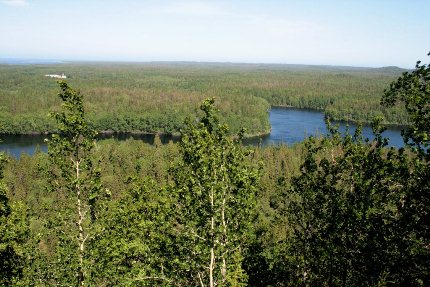
View from the hill
Anzer Island is situated just North West of the Big Island. It is famous for its mountains that the local monks called Golgotha after a mountain near Jerusalem where Jesus Christ was Crucified. According to a legend three centuries ago two monks Job and Paisy were working on this island then they saw a vision of Holy Mother of God, Mary. She told them to call this mountain a Golgotha and build a church here to honour the Biblical Golgotha. One of the monks was genuinely surprised for such a grim and strange choice for a namesake and asked maybe Holy Virgin a church devoted to herself. Holy Mary responded that this Golgotha is set for the Russian clergy. The monks abided and constructed a church here, named a mountain. Just two centuries later the prophecy came true and Solovetsky islands were turned into a concentration camp. Anzer Island had a hospital and a birth centre. Untold number of prisoners died here. There is no records and the building itself today lies in ruins.

No, this is not a Photoshop. It is an old birch on Golgotha in shape of a cross. By the way the only cross that miraculously survived being destroyed on the orders of political officer Uspensky in the 1920's was a cross that was erected here by brother Efrem on October 25th Julian Calendar or November 7th Western Calendar, 1917. Ironically it was the date of Russian Revolution that brought the Bolsheviks to power. It stands here on the Anzer Island. Solovetsky Crosses were big and required months of manual work. They marked holy places, graves and other important locations. Slowly, but surely their number on the islands of Solovetsky Archipelago grows.
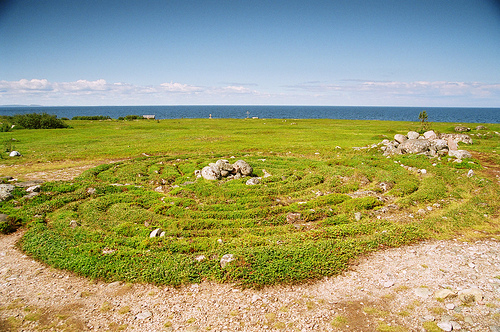
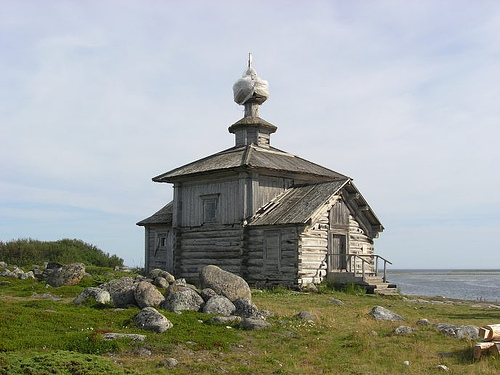
|
Sami called their religious megalith structures- Seyda. The most popular is located here on a Zayatsky Island, although there at least 30 such structures on the Solovetsky archipelago. There is no agreement on the purpose of the structure, but discovery of iron objects and burned human bones suggest that it had an important role in the cult of the dead. Age of construction is also uncertain. Most historians date it to 1st and 2nd centuries AD. |
Russian Orthodox Church Of Saint Andrew. This seemingly small and unimportant church was created by Russian Emperor Peter the Great and his sailors in the late 17th century. They managed to complete the task just in 6 days. Once they completed they blessed the first Naval Military Flag of Saint Andrew here. |
Solovetsky Kamen' (Stone) in Moscow covered by flowers and candles. Behind is the main building of Soviet Secret Police that had different named through its history: CheKa, NKVD, KGB and etc. Soviet Concentration Camp located within walls of the medieval Christian monastery that became widely known as Solovki became a symbol of oppressive totalitarian state. Shortly after a fall of Communism a stone from the monastery was brought here on Lyubyanka Square as a reminder of millions lost in Solovetsky Camp as well as other camps around former Soviet Union.
Professor A.E.Anisimov - art critic
I.P.Antsiferov - historian
Vladimir Artemyev - inventor
Professor S.A.Askoldov
V.W.Bakhton - inventor
Vladimir N. Beneshevich - historian, paleographer
A.V.Bobrishev-Pushkin - descendant of Decembrist Pavel Sergeievich
Bobrishev-Pushkin
I.E.Braz - artist
Leonid Feodorov - Bishop and Exarch of the Russian Catholic Church.
Pavel Alexandrovich Florensky - priest, scientist, encyclopaedist
G.J.Gordon - historian
A.K.Gorsky - poet
Archimandrite Illarion (Troitsky) - Professor of the Moscow Theological
Academy
Academician Dmitry Sergeyevich Likhachov - philologist
Mirjaqip Dulatuli- Kazakh writer
I.V. Popov - Professor of the Moscow Theological Academy
Varlam Shalamov - writer
Vladimir V. Tchernavin - ichthyologist
H.H.Vinogradov - ethnographer
Oleg V. Volkov - writer
M.N.Voronoy - poet
There is no exact list of casualties in this camp. The official number lists them at 8000 people, however many of the prisoners were used in various construction projects in the regions. Their numbers were not officially added to the number of dead. Thus about 8,700 men from the Solovki camp died during construction of Belomor- Baltiysky Channel.
Soviet documentary from 1928- 29 traces a journey from Moscow to Solovetsky Concentration Camp
Renewal of monastic life
On October 25, 1990,
the Holy Synod blessed the opening of the Spaso-Preobrazhensky
stavropegic monastery; Abbot Herman (Chebotar) was appointed acting
governor. In the autumn of the same year, the first novices
appeared.
By a decree of February 9, 1992, Patriarch Alexy II
appointed Abbot (now Archimandrite) Joseph (Bratishchev) as the
abbot of the monastery. Bishop Eulogius of Vladimir and Suzdal was
ordained as hegumen in the home church of the monastery.
On
August 19-21, 1992 the relics of the Monks Zosima, Savvaty and
Herman, the Solovetsky miracle workers, were transferred from St.
Petersburg to the monastery. The celebrations were led by Patriarch
Alexy II; August 22 (according to the new style) began to be
celebrated as the Cathedral of the Solovetsky Saints.
On
August 22, 1992, the Patriarch consecrated the gateway church of the
Annunciation of the Most Holy Theotokos, where the relics of the
Solovetsky miracle workers were placed. With the blessing of
Patriarch Alexy II, since 1993, the celebration of the Second
transfer of the holy relics of the Monks Zosima, Savvaty and Herman
has been established on August 8 (21), and the next day, August 9
(22), the memory of the Cathedral of the Solovetsky Saints is
commemorated.
Archaeological excavations and new construction
In 1997-2003, archaeological excavations were carried out on the
territory of the monastery with the aim of discovering the graves of
Saints Savvaty, Herman and Archbishop Markell of Vologda - his
white-stone tombstone was accidentally discovered near the fortress
wall north of the Arkhangelsk Tower. In 2002, the broken grave and
part of the relics of the Monk Herman were discovered, the next year
the intact grave of Markell was found. It was established that the
wooden tomb of 1545 of the Monk Savvaty from 1622 began to be called
the Tomb of Herman. In 1663, in its place began the construction of
a large wooden chapel of St. Herman, which in 1753 was rebuilt into
a stone chapel, and in 1859 a stone church was erected on this site.
“Markelle was buried in a wooden sarcophagus with a lid lined
with birch bark and punched along the edges with small iron nails.
The garment consisted of a phelonion and an omophorion of gold-woven
embroidery. On his head was an embroidered gold-woven cowl with an
image on the forehead of the Savior with a halo and cherubs on the
temples with the inscription: "Cherub". On the chest lay a panagia
made of two carved wooden plates, framed by a silver patterned
frame. On the belly there is a copper buckle with the remains of a
belt. At the feet are leather sandals. "
In 2015, the museum
collection was replenished with 877 items, 64 items were received in
the main fund of the museum, 37 of which are items from the
collection of stove relief polychrome ceramics, depicting horses and
floral ornaments. In 2016, the museum collection was replenished
with 1,783 items, of which 63 items were transferred to the main
fund of the museum.
In November 2007, Russian Minister of
Culture Mikhail Shvydkoi announced that a decision had been made to
completely remove the museum from the walls of the monastery. The
museum complex, 65 m long along the facade and more than 10 m high,
is planned to be built right under the walls of the monastery. The
total cost of construction exceeds 700 million rubles. After expert
protests in the fall of 2015, construction was suspended with the
intention of lowering its height by one floor. The director of the
Department for the Protection of Cultural Heritage of the Ministry
of Culture admitted the entire project was a mistake.
At the
same time, there were reports that the authorities decided to build
an airport in the immediate vicinity of the monastery. In 2015, a
mission of UNESCO experts, who visited the monastery, stated that
“the unceasing urbanization poses a serious threat” to the integrity
of the architectural ensemble. In 2016, at the World Heritage
Session, UNESCO did not include the monastery in the endangered
World Heritage List, but called for the construction of museum
buildings and the airport to be moved to a more suitable location.
Worship crosses
The memorial cross, carved by the monk
Diodorus, a monk of the Holy Ascension Skete, in honor of Saints
Anthony and Theodosius, the Pechersk miracle workers, was installed
on the Bolshoi Solovetsky Island six miles from the Solovetsky
Monastery on the way to the Isaac Skete, on the site of the chapel
in honor of Anthony and Theodosius, which was in the number of those
lost during the camp. This small wooden chapel, built at the end of
the 18th century, has long preserved a carved cross from the 17th
century.
In total, about 20 crosses were installed by the
Solovetsky Monastery in the late XX - early XXI centuries. According
to Archimandrite Joseph (Bratishchev), the governor of the
Solovetsky Monastery of the Savior Transfiguration, “the crosses
remind of the former greatness of the monastery, as they are
installed on the site of lost churches, chapels, and memorial
sites”.
Also in the summer, the Association of Northern
Navigation in the Bay of Prosperity installed an 8-meter Orthodox
cross on the stone luda of the Herdy Cape, which existed before 1917
and served as a kind of lighthouse. Also, on the initiative of the
partnership, a memorial cross was erected in 2002 on the site of the
Varvara chapel destroyed in the 1930s on the Solovetsky Islands.
In the summer of 2007, a river procession of the Cross "Way of
the Cross: Solovki - Butovo" was organized with the transfer of the
Great Poklonniy Cross from Solovki to Butovo, timed to coincide with
the 70th anniversary of the beginning of mass repressions in
1937-1938.
Monastery in philately, bonistics, numismatics
On the back of a Russian 500-ruble note (modifications up to 2010),
the Solovetsky Monastery was depicted from the side of the Holy
Lake. Contrary to the existing misconception, the gable roof was
replaced by “Dutch” pitched roofs before the revolution.
Since September 6, 2011, a 2010 modification note has been put into
circulation in Russia, on the reverse of which the image of the
Solovetsky Monastery has been significantly changed: a ship that had
previously moved along the Holy Lake was removed (this class of
ships was never used by monks and local residents), and the angle
was changed images of the monastery, based on the modern look of the
building.
Get in
There are two main ways to reach the Solovetsky
Islands: by air from Arkhangelsk, or by boat from Kem'/Belomorsk.
Nordavia Regional Airlines (a subsidiary of Aeroflot) fly the
50minute journey from Solovki to Arkhangelsk up to twice a week.
Prices start at approximately RUB5000 one way. The airport is in
close proximity to the monastery and the islands' main settlement.
By boat from Kem': Kem' is easily accessible as a stop on the
Petersburg-Murmansk mainline. From there, it is 12km to the port
settlement of Rabocheostrovsk, a journey that can be done either by
bus (regularly from 6am) or by taxi. In the summer season, boats
leave three times a day (June-August 2016: 8:00, 12:30, 17:30), take
2 hours, and cost RUB1200 for an adult. Booking the journey out to
Solovki is advised, as it regularly books up fully. If, however, you
arrive and have not booked, there are boats owned by the monastery
that leave at 7am (frequency uncertain), and it has been suggested
that they are reluctant to leave people stranded in Rabocheostrovsk.
The cost is also RUB1200, and definitely an experience!
By
boat from Belomorsk: Belomorsk is also accessible by rail, boats
leave daily to Solovki, taking 4 hours and costing RUB1200.
By boat from Arkhangelsk: In the summer months, boats also ply the
route between Arkhangelsk and Solovki (up to three times a month)
but it is worth consulting a travel agent about this for prices and
availibility
Get around
There is no paved road.
Hotel Priyut: nice and clean, 1900 roubles for a single with
common bathroom
Peterburgskaya Obshchezhitie (Petersburg
Hostel) has beds for as low as RUB450, but booking in advance by
phone is essential in peak season. (+88183590375)
Apartment
on Primorskaya 9 (Natalya's Apartment) (Walk 7 minutes heading SW
from the monastery.), e-mail: stypkina@gmail.com Natalya has a cute
single room for $22 (as of Summer 2018) and a living room that can
accommodate up to 4 people for $70 with breakfast included. She also
offers home-cooked meals for a reasonable price. You'll want to eat
here; she was the former cook at the monastery. There is one shared
bathroom with a toilet and shower with hot water. No wifi. Natalya
speaks conversational English and normally spends the winters in
Moscow. $22-$70.
Connect
Sloboda hotel is the only place to access
semi-reliable wifi on the island - RUB100 for 24hours access.